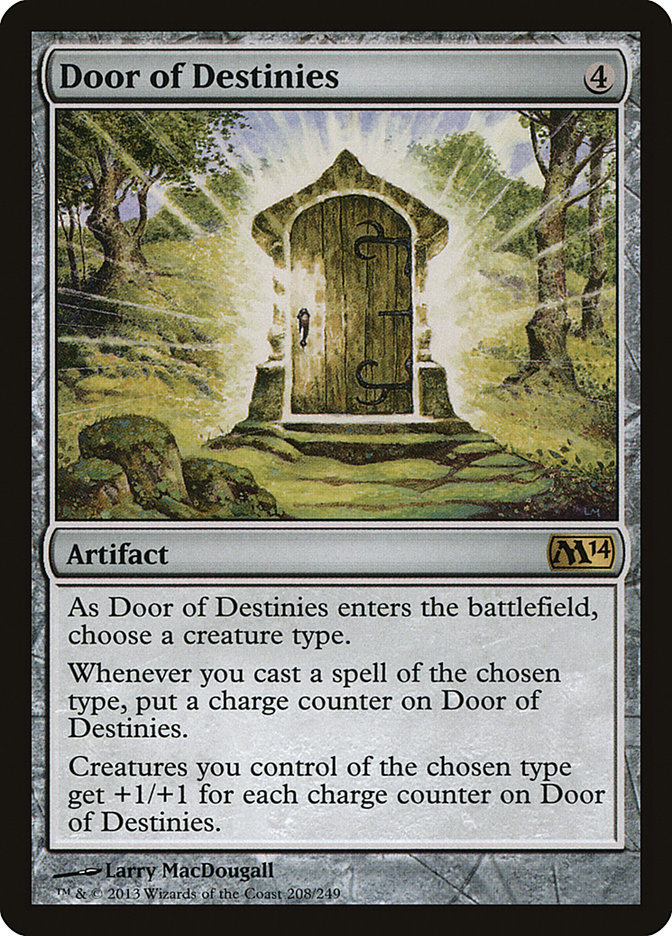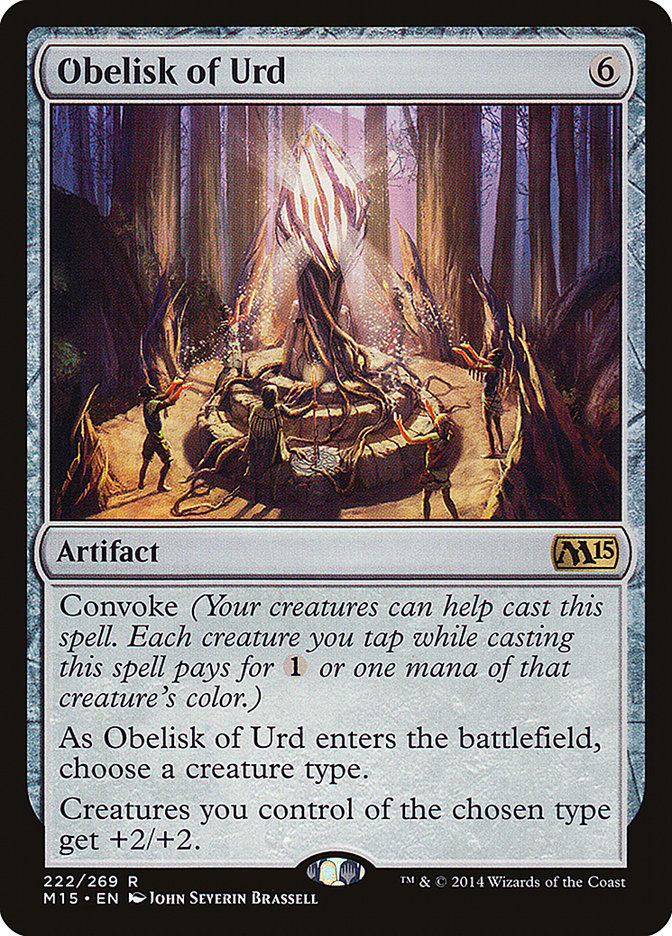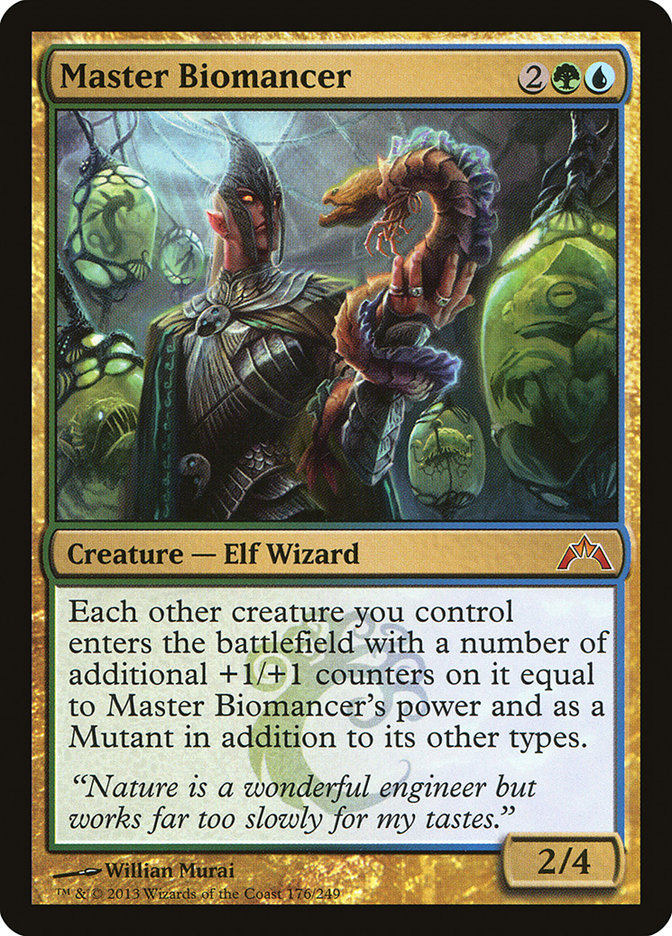My favorite four-word phrase in Magic is “choose a creature type.”
One of the most important facets of Magic’s lore lies in its tribal aspect, the solidarity and power given to a particular creature type that makes them
all more effective. People have loved building Elf decks, Wizard lists, and Ooze brews since creatures had a subtype. For nearly as long as the tribal
craze has flourished, artifacts have been at the center of many of those strategies.
Coat of Arms has always been the mother of tribal artifacts. It applied to everyone, which made it sufficiently difficult to count, and people almost
always misread it, but Coat of Arms has acted as the base of many fun tribal lists over the years. Some more standardized variations have emerged, but very
few have had the quiet, strong power of the newest child in the family: Obelisk of Urd.
This provides a serious pump effect for very little; an army of 1/1s can quickly turn into a terrifying legion of death. Obelisk of Urd got some press shortly
after it was spoiled and, more recently, it has seen Pro-Tour-level play in
a popular R/W Soldiers deck that hopes to stick this costly behemoth as early as the third turn.
The best part about the Obelisk and its predecessors is their “artifact-ness” often means they can apply to any tribe, no matter how obscure. Obelisk of
Urd obviously works well with the typical tribal-centric races and classes; Goblins, with their low cost and aggressive nature, benefit from any global
anthem. When choosing which creature to pump in Standard, however, I feel strongly that less conventional tribes might benefit from the help of a little
boost too.
As I set out to brew with the Obelisk, I chose to limit the creature types I’d build based around three factors. First, the tribe must
have at least five cards in the tribe in Standard. This rule should always exist when you’re looking into a tribal build. Even when you’re aiming for the
fences with a wacky tribe, our current format has blessed us with Mutavault which can beef up the creature count as needed. Second, the tribe must have at
least two creatures within it that cost one mana. Although it’s fun to play things like Giant Tribal, we want cheap guys who can not only help with casting
the Obelisk, but they also benefit significantly once it’s on the table. Finally, we will be avoiding the typical tribes for each color: Soldiers, Merfolk,
Zombies, Goblins, and Elves. Sure, decks of those can be had, but I’m more interested in the more offbeat choices.
Okay, let’s become Human Wizards and start it off!
Bird is the Urd
I’m so sorry.
Although it’s true that Birds had a short stint as a tribal choice back in Onslaught Block, they’ve not gotten much since. Thankfully for them, the variety
of small, powerful creatures gives them a wing and a prayer for a good Standard list.
Creatures (24)
- 4 Suntail Hawk
- 4 Welkin Tern
- 4 Judge's Familiar
- 4 Seller of Songbirds
- 4 Cloudfin Raptor
- 4 Warden of Evos Isle
Lands (22)
Spells (14)

Cloudfin Raptor and Judge’s Familiar see play already, so it’s not too much of a stretch to imagine them side-by-side. Suntail Hawk, a measly Flying Men,
keeps the deck consistent, as does Welkin Tern. Warden of Evos Isle only reduces the cost of itself and Welkin Tern, but Birds are infrequent enough we’ll
take a Wind Drake with just a dash of upside. Seller of Songbirds provides a Bird token while also giving an extra body for both Military Intelligence and
for convoking out the big ‘Lisk. Twelve one-drops helps Military Intelligence be a live draw, and Azorius Keyrune plays well with sorcery speed removal,
and it also helps you get an Obelisk out when you’ve only got a couple creatures. Spear of Heliod and Hall of Triumph provide early power to make those
awkward borderline openers into beatdown keeps.
This one is potentially the most linear and straightforward of the day. What can we do to up the ante?
Elements of Surprise
Elementals are among my absolute favorite tribes. My Horde of Notions Commander deck is my longest running and most enjoyable list, and its synergies
border on deranged. Elementals have always been a favorite in fantasy lore; the idea of a natural, primordial force manifesting in a physical form never
stopped being cool.
Thankfully, Elementals are present across the breadth of Magic, and Standard is no exception.
Creatures (23)
- 3 Nivmagus Elemental
- 3 Young Pyromancer
- 3 Mindsparker
- 3 Ember Swallower
- 4 Master of Waves
- 3 Vortex Elemental
- 4 Generator Servant
Lands (24)
Spells (13)

Unlike Birds, which flock to white and blue almost exclusively, Elementals span every color in Magic. While Voice of Resurgence is potentially the most
notable of Elementals, it doesn’t share colors with the most exciting Elemental producers in the format. Thus, we went down the Elemental token path, rich
with high-powered, Standard-ready producers.
Vortex Elemental is a card that has seen exactly zero play since its introduction in January. While it’s true that better one-drops exist, Vortex Elemental
has the unique ability of eliminating the largest ground threat your opponent can muster for just two blue mana. Keeping a blue up is pretty easy,
especially while you’re representing other spells. With Obelisk of Urd, the Vortex can start being an offensive force too. Nivmagus Elemental, while
seemingly more of a Weird thanks to its Izzet heritage, becomes a pretty scary 3/4 after sticking an obelisk. Young Pyromancer and Master of Waves both
produce Elemental tokens, but they fundamentally conflict with one another. On one hand, Young Pyromancer wants you to cast lots of cheap, efficient spells
to generate elementals, while Master of Waves wants you to stick blue-heavy permanents in order to leverage two-digit power out of four mana. What’s worse,
Obelisk of Urd doesn’t help either by itself because it’s not an instant or a colored permanent. Nevertheless, both are powerful enough that the compromise
is sufficient to keep both happy. Alternatively, you can always name Wizard.
Mindsparker is by far the least used enemy hate creature cycle from M14. Despite its formidable combat stats, it was too slow to help in the early game and
too weak to stand up to the X/4s White, Blue, and Green can deploy. However, as an Elemental with an attitude, I don’t mind having a five-power creature
packing first strike. As with the Bird deck, these choices are merely to create formidable combat stats, even if the base creature is underwhelming. Ember
Swallower is a card I am surprised hasn’t seen more play. Being a 4/5 is pretty nice in a world with Last Breath, Mizzium Mortars, and Selesnya Charm. Its
ultimate might occasionally come up, but more often than not, even an aggressive deck won’t be able to breach or effectively block such a towering red
bruiser.
With so many cheap creatures, Stoke the Flames can efficiently batter a creature or player. Young Pyromancer tokens, which are also created by the spell,
can help too. Master of Waves and its seahorses can help you but only for the colorless portion. Shock is meant to defend oneself early, but it also acts
as a nice turn 3 play after resolving a Young Pyromancer. A set of the Obelisk still seems essential, and the token production will reduce the workload on
the actual creatures to be pumped. Molten Birth has the potential to provide a surprising number of Elementals with a lucky flip or two.
Teenage Mutant Ninja Urdles
Mutants. This creature type has consistently belonged to the Simic Combine since its inception nearly a decade ago. A quick search for Mutants reveals that
they break the first two rules of the game: there are only four Mutants in Standard, and only one of them is a one-drop (Cloudfin Raptor, who we’ve already
met once today.) How can this be a legitimate choice?
This little devil makes everything you play a Mutant. Therefore, not only does everything you cast get their own personal Obelisk of Urd in the form of two
+1/+1 counters, but it also works alongside the Obelisk to garner a mondo-bonus.
Relieving ourselves from this limit also gives us the advantage of building a deck using traditionally strong cards right alongside some new faces.
Creatures (28)
- 4 Burning-Tree Emissary
- 3 Cloudfin Raptor
- 4 Experiment One
- 4 Master Biomancer
- 4 Elvish Mystic
- 2 Sylvan Caryatid
- 1 Prophet of Kruphix
- 4 Voyaging Satyr
- 2 Kiora's Follower
Lands (24)
Spells (8)

This list shared a great deal in common with many mono-green lists, but with the Biomancer (and ways to search it up), you can play whatever you want and
it’ll grow bigger; even mana creatures can become massive with a late-game cast.
As fun as Standard is to mess with, the Obelisk left me feeling a bit disappointed. It didn’t feel, well, colorless. All of the format’s playable creatures
have subtypes like Thopter, Horror, and Construct, allowing little wiggle room to force a truly colorless aggressive deck.
Well, in Standard that is.
That’s right. The little mana critters from Mirrodin and the recent return to the plane are another favorite tribe for me. These little clockwork,
bird-like critters have the built-in ability to cast high-mana spells. What happens when we add in another recent M15 print and move this thing back to the
middle ages of Magic?
Creatures (29)
- 4 Myr Servitor
- 4 Etherium Sculptor
- 4 Myr Galvanizer
- 4 Myr Battlesphere
- 1 Shimmer Myr
- 4 Treasure Mage
- 4 Myr Superion
- 4 Chief Engineer
Lands (22)
Spells (9)

Now that’s some intense action! Myr Superion can be cast for free off a Chief Engineer and one other creature, and resolving as many Myrs as possible makes
battling to the death a powerful reality. Treasure Mage can find an Obelisk, a Myr Battlesphere, or a Darksteel Forge, if the situation calls for it. Who
knows if this deck is fast or powerful enough for even a casual event, but the dream is worth living!
Next week, I’ll be playing in my first PTQ in years, and I’ve been fine-tuning a tournament-ready Modern list for months; Modern continues to be an
exciting, enjoyable format, and I love to watch it grow!
Have you dabbled in the Urd? What odd creatures have you reached for both at the kitchen table and the tournament table?




